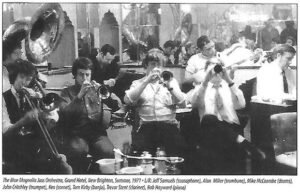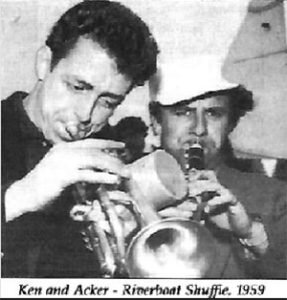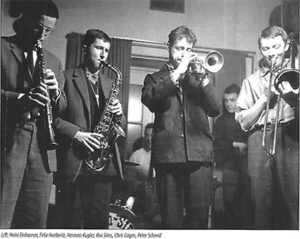On 4th June Jazz&Jazz featured:
The Big Debate: Is Jazz Facing “Doom & Gloom”? but concluded
“All Is Far From Lost!”
To measure reaction I posted two follow up features on my Jazz&Jazz Facebook Page in two posts entitled: “Picking Up The Pieces” Parts 1 & 2. For those who prefer not to access Facebook, these are featured below.
PICKING UP THE PIECES! Part 1
I posted twice on Facebook yesterday (6th June). Both entries received rapid responses with a spate of mixed comments. So how to pick up the pieces?

Pete Lay
 First I should say that I hadn’t intended to re-address the issue of “generational” jazz. But as Pete Lay, Editor of Just Jazz, commented on Jazz North West in response to Jeff Matthews’ claim that “There are very few people in their 20’s interested in jazz of any sort, let alone New Orleans, however good it is”, I felt I should.
First I should say that I hadn’t intended to re-address the issue of “generational” jazz. But as Pete Lay, Editor of Just Jazz, commented on Jazz North West in response to Jeff Matthews’ claim that “There are very few people in their 20’s interested in jazz of any sort, let alone New Orleans, however good it is”, I felt I should.
Pete responded:
“…check out the young jazz scenes in Manchester, Leeds and especially the London area, where there is a large jazz following among the Swing Dance crews and the Jivers, with loads of young musicians and bands – one only has to check out Facebook on a daily basis to read about them – that’s their PR centre – Social Media. And in New Orleans and at the Festivals in the USA the average age of musicians and dancers has halved. Check out the Bix Fest, San Diego Fest on You Tube or the French Market Dance Stage at the French Quarter Festival in New Orleans – or where their young bands are filling concert halls playing to young jazz fans and dancers.

Jazz&Jazz Photographer Laurence Cumming visited “The Spotted Cat” during The French Quarter Festival this year. (© Laurence Cumming, Jazz&Jazz 2016)
It’s quite exhilarating!! And gives me great hope for the future – for instance: Bombay Club on Conti Street one Saturday in April this year. A young band – average age mid to late 20s/early 30s – playing tunes from the repertoires of the Halfway House Orchestra, The New Orleans Owls, Armand J Piron, Kid Ory … Nope, our music ain’t dying, just being re-invented for a new age group. We have to find them, don’t expect them to look for us ‘old farts’.”
Pete continued: “Yes, of course, all the usual jazz clubs are full of grey heads. The young scene is not typical of our experience. They have their own venues, own clubs, own bands and specifically their own audiences. I’m sure if you were to dig under the surface, you’d find what’s happening in Manchester and Leeds. I don’t want to get into a slanging match with folk, but I tend to find most ‘grey heads’ feel the scene is dying and are not readily accepting that the underground movement for keeping Vintage and Early Swing music alive is safe and well among younger musos. One only has to look at the huge number of young musos involved at Whitley Bay Jazz Festival. So many are still totally unaware of what is happening in and around London. If it happens in London, it generally is happening in some shape in other capital cities.”
Fred Burnett then commented:
“I agree with Pete on this one, young people are finding our music, even if it comes under the latest ‘vintage’ craze, or via a Swing/Lindy dancing class.”
John Musket chipped in:
“Suburban or rural locations for gigs may be preferred by older players and older listeners. A hassle-free drive, free parking at the venue and a straightforward drive home are welcome. For young people without cars there are transport problems: no convenient late night trains or buses, and few taxis (and no clubs to move on to).
Norman Gibson contributed:
I am very pleased to see Pete’s confidence in the young. In the UK we’re at least eight years behind Sweden, in particular, Europe and USA, but the young here are catching up fast and it is the dancing which is key. Pete is obviously keeping a keen eye on developing younger bands, knows the importance of social media and could well be the first big promoter here to ‘bring it on’ when next he gambles on the young !
Pete Lay concluded:
The ‘young – old’ thing is always going to get mixed reaction. I thought Norman Gibson’s response was good. I’m still trying to conjure up ideas to get some of the ‘younger fans, dancers etc’ to get out into ‘the sticks’ and savour one of our jazz breaks. Trying some more younger bands at Mill Rythe in 2018, so here’s hoping. I know we have some of the younger bands on side – that’s the easy bit, but it’s their followers who are the problem – they can stay put in London and still have a good time.
PICKING UP THE PIECES! Part 2
First I should explain what provoked Picking Up The Pieces Part 2! And there is no better way than quoting extracts from my Jazz&Jazz Feature: “Telling It As It Was: Sharing The Memories of Ken Sims” , followed by my later feature, “The Big Debate: (No Way) Is Jazz Facing “Doom & Gloom”?
So, quoting from Ken’s own experiences in those early “glory years” when jazz was tops:
“Cy offered me a trial period with his band. Most of this period was spent on his farm in Essex, learning his collection of Oliver, Armstrong, Morton and Dodds records. After the trial period ended I got the job and was paid the princely sum of £12 per week. My bed-sit cost me £5 per week.”

The Blue Magnolia Jazz Band
“Later that year I joined the remnants of the Wallasey College of Art Jazz Band, who called themselves the Blue Magnolia Jass Orchestra. I got 7s 6d, the equivalent of 37p, for the first gig. It would be fair to say that certain technical deficiencies were evident. They did, however, develop an enormous swing. I don’t know how they did it, but they did. Well, you can learn technique. I took over leadership of the band and instigated rehearsals, and things slowly got better; sometimes we got paid more than we drank. The band had Ken Dickeson on the goddam fish horn (soprano sax), Alan Miller (trombone), Jeff Samuels (sousaphone), Geoff Walker (banjo), John Cochran (drums) and Bob Hayward (piano).”

Golden days with Acker!
“By 1962, the idealism and sincerity that had fuelled the revival had been diluted by commercialism. Humph escaped into Mainstream; Cy abandoned his fans and went to India to commune with his god. Of the big three revivalists who played the clubs, the Guv’nor stood alone. I do not include Chris Barber in this group because Chris has always appeared to me to be the consummate professional bandleader who has always run a commercially successful jazz band, even during an era when to be called commercial was an insult to one’s musical integrity. The silver thread that identifies all his bands is, for me, his love of Traditional Jazz and the crystal clear lead provided by his trumpeter, Pat Halcox, a wonderful player.”

Alan Cooper
“In late 1966 times were hard, and yet I was playing! The money wasn’t much, but the jazz was a bit good, at times wonderful. Alexander’s Jazz Band should have been called Barton Bros Inc. Len Barton ran the band and played bass; brother Ken played banjo and guitar and sang; brother Graham played piano. Ian Castle completed the rhythm section, on drums. The frontline was usually Alan Cooper, Forrie Cairns or Will Hastie on clarinet, Dave Hewett on trombone, and myself. The Johnny Parker band felt like home to me.”
“1967 was time to settle down. Real job, lovely wife, house, mortgage, all the bits. London house prices were out of the question, also I needed some assistance to get back into engineering, so it was back to de Pool. With a bit of help from my dad, at that time Chief Engineer, Liverpool Corporation, I got a job with the Liverpool Heating and Ventilating Co. I worked five, sometimes six days a week; in the winter months I studied engineering at night; at weekends and during the summer months I renovated the house. In between times I played my cornet.”
“The gradual decline in attendance was due, I think, to the natural tendency of our audiences to settle down, marry and raise children – expensive hobbies. Those who left the scene were not replaced in sufficient numbers by the younger generation, most of whom wanted their own heroes and who, in the main, preferred the music of the young R&B singers, such as Stewart, Beck, Jagger and Lennon, etc.”
“Consider that at this time there were 140 plus jazz clubs booking professional bands, some more than once a week, I didn’t know 140 top class, professional Traditional jazz musicians, never mind 140 top class bands. The result was fairly predictable. There were some bands with just one or two good musicians in them and some with none. Bands wearing silly uniforms proliferated like fungus on a dead tree. My dreams of playing jazz for a living were turning to dust, so I went to see my agent, Lyn Dutton, at his lair in Great Chapel Street. When I got there, trombonist/bandleader Dave Keir was giving a member of the staff a frightful ear-bashing. Despite his impassioned oratory, it was plain to me that he was getting nowhere. Eventually he left, to a slamming of doors that shook the building. Silence. Colin Hogg of the agency appeared. “Come in,” he said, ushering me into his office. The situation was worse than I thought. Some of the clubs that had started in the last few years were folding, and many of the clubs still operating were paying such small fees that it was not worth the agency’s time to deal with them. He could, however, get me work in Germany.”
 “Most of the lads in my band did not fancy working six to eight hours a night, seven nights a week in Germany. To me, it seemed preferable to doing maybe three or four gigs a week somewhere
“Most of the lads in my band did not fancy working six to eight hours a night, seven nights a week in Germany. To me, it seemed preferable to doing maybe three or four gigs a week somewhere
in the UK.”
“In London, The Marquee Club was somehow combining R&B and Mainstream/Modern jazz. John Baldry had recovered from his electrocution and was performing there with his Hoochie Coochie Men, featuring Rod Stewart. He was also working with a group called Blues Incorporated, which included in its ranks Mick Jagger and Charlie Watts.”
Have Your Say!
So, Jazz Fans, you think jazz is having a tough time today!? Now is the time to have your say here on Jazz&Jazz in “Comments” below.
Also why not search the pages of Jazz&Jazz where you will find many posts featuring younger bands from the UK, USA and Europe. Also, I have been fortunate to film them for Jazz&Jazz YouTubes so, beside here on Jazz&Jazz, why not spend a little time delving into my Jazz&Jazz YouTubes Channel.
Peter M Butler
Editor & Proprietor Jazz&Jazz
(Photos © Peter M Butler, Jazz&Jazz)
Where are all the jazz songwriters ? I am one. I think jazz is as dead as the material and the players. The players are young now, but the are playing material from 70 years ago. Why is that.
Hi Peter,
I am one of those who wish to see and hear both the ‘best of the oldies’ and ‘the new kids on the block’. But I do not find the latter easy, and when I have looked for their haunts in London, with the aim of checking them out, I have drawn a blank. Likewise, when thinking to visit Barcelona hoping to find ‘San Andreu Jazz Band graduates’ appearing, I drew a blank. Maybe that is because I am not ‘into’ Facebook, and part of this article points out I need to be.
So I have tried, and not done much better – guess I am too old to embrace social media. But I suspect Jazz musicians and promoters amongst us ‘oldies’ will have to.